Testhyperlink123: Difference between revisions
Jump to navigation
Jump to search
Guptareeya53 (talk | contribs) No edit summary |
Guptareeya53 (talk | contribs) No edit summary |
||
| Line 23: | Line 23: | ||
'''publication''' : [https://pubmed.ncbi.nlm.nih.gov/28392398 28392398]|[https://pubmed.ncbi.nlm.nih.gov/25787850 25787850]|[https://pubmed.ncbi.nlm.nih.gov/23471986 23471986]|[https://pubmed.ncbi.nlm.nih.gov/2559078 2559078]|[https://pubmed.ncbi.nlm.nih.gov/32455599 32455599]|[https://pubmed.ncbi.nlm.nih.gov/2663859 2663859]|[https://pubmed.ncbi.nlm.nih.gov/32796033 32796033]|[https://pubmed.ncbi.nlm.nih.gov/3517161 3517161]|[https://pubmed.ncbi.nlm.nih.gov/20082214 20082214]|[https://pubmed.ncbi.nlm.nih.gov/30853699 30853699]|[https://pubmed.ncbi.nlm.nih.gov/15279935 15279935]|[https://pubmed.ncbi.nlm.nih.gov/26104834 26104834]|[https://pubmed.ncbi.nlm.nih.gov/20732996 20732996]|[https://pubmed.ncbi.nlm.nih.gov/30224239 30224239]|[https://pubmed.ncbi.nlm.nih.gov/31142708 31142708]|[https://pubmed.ncbi.nlm.nih.gov/30338271 30338271]|[https://pubmed.ncbi.nlm.nih.gov/25033755 25033755]|[https://pubmed.ncbi.nlm.nih.gov/30413389 30413389]|[https://pubmed.ncbi.nlm.nih.gov/7104376 7104376]|[https://pubmed.ncbi.nlm.nih.gov/29866658 29866658]|[https://pubmed.ncbi.nlm.nih.gov/24983355 24983355]|[https://pubmed.ncbi.nlm.nih.gov/6794884 6794884]|[https://pubmed.ncbi.nlm.nih.gov/31361021 31361021]|[https://pubmed.ncbi.nlm.nih.gov/21740983 21740983]|[https://pubmed.ncbi.nlm.nih.gov/33168837 33168837]|[https://pubmed.ncbi.nlm.nih.gov/31752441 31752441]|[https://pubmed.ncbi.nlm.nih.gov/28123520 28123520]|[https://pubmed.ncbi.nlm.nih.gov/29068380 29068380]|[https://pubmed.ncbi.nlm.nih.gov/24841197 24841197]|[https://pubmed.ncbi.nlm.nih.gov/27932383 27932383]|[https://pubmed.ncbi.nlm.nih.gov/28535204 28535204]|[https://pubmed.ncbi.nlm.nih.gov/31691795 31691795]|[https://pubmed.ncbi.nlm.nih.gov/27916888 27916888]|[https://pubmed.ncbi.nlm.nih.gov/27558838 27558838]|[https://pubmed.ncbi.nlm.nih.gov/10227680 10227680]|[https://pubmed.ncbi.nlm.nih.gov/26464281 26464281]|[https://pubmed.ncbi.nlm.nih.gov/22348006 22348006]|[https://pubmed.ncbi.nlm.nih.gov/22279060 22279060]|[https://pubmed.ncbi.nlm.nih.gov/25156739 25156739]|[https://pubmed.ncbi.nlm.nih.gov/32314902 32314902]|[https://pubmed.ncbi.nlm.nih.gov/22718629 22718629]|[https://pubmed.ncbi.nlm.nih.gov/23701631 23701631]|[https://pubmed.ncbi.nlm.nih.gov/23906628 23906628]|[https://pubmed.ncbi.nlm.nih.gov/8613382 8613382]|[https://pubmed.ncbi.nlm.nih.gov/23555772 23555772]|[https://pubmed.ncbi.nlm.nih.gov/20059899 20059899]|[https://pubmed.ncbi.nlm.nih.gov/7868240 7868240] <br> | '''publication''' : [https://pubmed.ncbi.nlm.nih.gov/28392398 28392398]|[https://pubmed.ncbi.nlm.nih.gov/25787850 25787850]|[https://pubmed.ncbi.nlm.nih.gov/23471986 23471986]|[https://pubmed.ncbi.nlm.nih.gov/2559078 2559078]|[https://pubmed.ncbi.nlm.nih.gov/32455599 32455599]|[https://pubmed.ncbi.nlm.nih.gov/2663859 2663859]|[https://pubmed.ncbi.nlm.nih.gov/32796033 32796033]|[https://pubmed.ncbi.nlm.nih.gov/3517161 3517161]|[https://pubmed.ncbi.nlm.nih.gov/20082214 20082214]|[https://pubmed.ncbi.nlm.nih.gov/30853699 30853699]|[https://pubmed.ncbi.nlm.nih.gov/15279935 15279935]|[https://pubmed.ncbi.nlm.nih.gov/26104834 26104834]|[https://pubmed.ncbi.nlm.nih.gov/20732996 20732996]|[https://pubmed.ncbi.nlm.nih.gov/30224239 30224239]|[https://pubmed.ncbi.nlm.nih.gov/31142708 31142708]|[https://pubmed.ncbi.nlm.nih.gov/30338271 30338271]|[https://pubmed.ncbi.nlm.nih.gov/25033755 25033755]|[https://pubmed.ncbi.nlm.nih.gov/30413389 30413389]|[https://pubmed.ncbi.nlm.nih.gov/7104376 7104376]|[https://pubmed.ncbi.nlm.nih.gov/29866658 29866658]|[https://pubmed.ncbi.nlm.nih.gov/24983355 24983355]|[https://pubmed.ncbi.nlm.nih.gov/6794884 6794884]|[https://pubmed.ncbi.nlm.nih.gov/31361021 31361021]|[https://pubmed.ncbi.nlm.nih.gov/21740983 21740983]|[https://pubmed.ncbi.nlm.nih.gov/33168837 33168837]|[https://pubmed.ncbi.nlm.nih.gov/31752441 31752441]|[https://pubmed.ncbi.nlm.nih.gov/28123520 28123520]|[https://pubmed.ncbi.nlm.nih.gov/29068380 29068380]|[https://pubmed.ncbi.nlm.nih.gov/24841197 24841197]|[https://pubmed.ncbi.nlm.nih.gov/27932383 27932383]|[https://pubmed.ncbi.nlm.nih.gov/28535204 28535204]|[https://pubmed.ncbi.nlm.nih.gov/31691795 31691795]|[https://pubmed.ncbi.nlm.nih.gov/27916888 27916888]|[https://pubmed.ncbi.nlm.nih.gov/27558838 27558838]|[https://pubmed.ncbi.nlm.nih.gov/10227680 10227680]|[https://pubmed.ncbi.nlm.nih.gov/26464281 26464281]|[https://pubmed.ncbi.nlm.nih.gov/22348006 22348006]|[https://pubmed.ncbi.nlm.nih.gov/22279060 22279060]|[https://pubmed.ncbi.nlm.nih.gov/25156739 25156739]|[https://pubmed.ncbi.nlm.nih.gov/32314902 32314902]|[https://pubmed.ncbi.nlm.nih.gov/22718629 22718629]|[https://pubmed.ncbi.nlm.nih.gov/23701631 23701631]|[https://pubmed.ncbi.nlm.nih.gov/23906628 23906628]|[https://pubmed.ncbi.nlm.nih.gov/8613382 8613382]|[https://pubmed.ncbi.nlm.nih.gov/23555772 23555772]|[https://pubmed.ncbi.nlm.nih.gov/20059899 20059899]|[https://pubmed.ncbi.nlm.nih.gov/7868240 7868240] <br> | ||
'''definition''' : An amino tetrasaccharide consisting of 2-acetamido-2-deoxy-β-D-galactopyranosyl, α-D-galactopyranosyl, β-D-galactopyranosyl, and β-D-glucopyranose units joined together in sequence by (1→3), (1→4), and (1→4) glycosidic linkages, respectively.[CHEBI:145578] <br> | '''definition''' : An amino tetrasaccharide consisting of 2-acetamido-2-deoxy-β-D-galactopyranosyl, α-D-galactopyranosyl, β-D-galactopyranosyl, and β-D-glucopyranose units joined together in sequence by (1→3), (1→4), and (1→4) glycosidic linkages, respectively.[CHEBI:145578] <br> | ||
'''term_xref''' : GlycoMotif:GGM.000070|GlycoEpitope:EP0073|CID: | '''term_xref''' : GlycoMotif:GGM.000070|GlycoEpitope:EP0073|CID:5288889|CHEBI:145578|SugarBind_Ligand:18|MeSH:C024032<br> | ||
'''synonyms''' : Gb4Cer|Gb4|Globoside|P antigen|Cytolipin K <br> | '''synonyms''' : Gb4Cer|Gb4|Globoside|P antigen|Cytolipin K <br> | ||
'''function''' : <br> | '''function''' : <br> | ||
| Line 39: | Line 39: | ||
'''publication''' : [https://pubmed.ncbi.nlm.nih.gov/32127409 32127409]|[https://pubmed.ncbi.nlm.nih.gov/28674962 28674962]|[https://pubmed.ncbi.nlm.nih.gov/30875019 30875019]|[https://pubmed.ncbi.nlm.nih.gov/30413389 30413389]|[https://pubmed.ncbi.nlm.nih.gov/31778662 31778662]|[https://pubmed.ncbi.nlm.nih.gov/31101366 31101366]|[https://pubmed.ncbi.nlm.nih.gov/24335674 24335674]|[https://pubmed.ncbi.nlm.nih.gov/31241709 31241709]|[https://pubmed.ncbi.nlm.nih.gov/24158513 24158513]|[https://pubmed.ncbi.nlm.nih.gov/28947349 28947349]|[https://pubmed.ncbi.nlm.nih.gov/31566927 31566927]|[https://pubmed.ncbi.nlm.nih.gov/28672034 28672034]|[https://pubmed.ncbi.nlm.nih.gov/31939530 31939530]|[https://pubmed.ncbi.nlm.nih.gov/29530250 29530250]|[https://pubmed.ncbi.nlm.nih.gov/27851774 27851774]|[https://pubmed.ncbi.nlm.nih.gov/26426881 26426881]|[https://pubmed.ncbi.nlm.nih.gov/25031264 25031264]|[https://pubmed.ncbi.nlm.nih.gov/29982630 29982630]|[https://pubmed.ncbi.nlm.nih.gov/24496231 24496231]|[https://pubmed.ncbi.nlm.nih.gov/29983334 29983334]|[https://pubmed.ncbi.nlm.nih.gov/28756410 28756410]|[https://pubmed.ncbi.nlm.nih.gov/27190352 27190352]|[https://pubmed.ncbi.nlm.nih.gov/29274327 29274327]|[https://pubmed.ncbi.nlm.nih.gov/29099167 29099167]|[https://pubmed.ncbi.nlm.nih.gov/28402705 28402705]|[https://pubmed.ncbi.nlm.nih.gov/23680766 23680766]|[https://pubmed.ncbi.nlm.nih.gov/28625968 28625968]|[https://pubmed.ncbi.nlm.nih.gov/26960552 26960552]|[https://pubmed.ncbi.nlm.nih.gov/26797827 26797827]|[https://pubmed.ncbi.nlm.nih.gov/22742555 22742555]|[https://pubmed.ncbi.nlm.nih.gov/27756537 27756537]|[https://pubmed.ncbi.nlm.nih.gov/31630715 31630715]|[https://pubmed.ncbi.nlm.nih.gov/3827883 3827883]|[https://pubmed.ncbi.nlm.nih.gov/28384397 28384397]|[https://pubmed.ncbi.nlm.nih.gov/29523338 29523338]|[https://pubmed.ncbi.nlm.nih.gov/31010832 31010832]|[https://pubmed.ncbi.nlm.nih.gov/27195818 27195818]|[https://pubmed.ncbi.nlm.nih.gov/26661087 26661087]|[https://pubmed.ncbi.nlm.nih.gov/23093409 23093409]|[https://pubmed.ncbi.nlm.nih.gov/30879639 30879639]|[https://pubmed.ncbi.nlm.nih.gov/27081853 27081853]|[https://pubmed.ncbi.nlm.nih.gov/17409683 17409683]|[https://pubmed.ncbi.nlm.nih.gov/29921669 29921669]|[https://pubmed.ncbi.nlm.nih.gov/25575293 25575293]|[https://pubmed.ncbi.nlm.nih.gov/26291612 26291612]|[https://pubmed.ncbi.nlm.nih.gov/23146289 23146289]|[https://pubmed.ncbi.nlm.nih.gov/25857295 25857295]|[https://pubmed.ncbi.nlm.nih.gov/26070511 26070511] <br> | '''publication''' : [https://pubmed.ncbi.nlm.nih.gov/32127409 32127409]|[https://pubmed.ncbi.nlm.nih.gov/28674962 28674962]|[https://pubmed.ncbi.nlm.nih.gov/30875019 30875019]|[https://pubmed.ncbi.nlm.nih.gov/30413389 30413389]|[https://pubmed.ncbi.nlm.nih.gov/31778662 31778662]|[https://pubmed.ncbi.nlm.nih.gov/31101366 31101366]|[https://pubmed.ncbi.nlm.nih.gov/24335674 24335674]|[https://pubmed.ncbi.nlm.nih.gov/31241709 31241709]|[https://pubmed.ncbi.nlm.nih.gov/24158513 24158513]|[https://pubmed.ncbi.nlm.nih.gov/28947349 28947349]|[https://pubmed.ncbi.nlm.nih.gov/31566927 31566927]|[https://pubmed.ncbi.nlm.nih.gov/28672034 28672034]|[https://pubmed.ncbi.nlm.nih.gov/31939530 31939530]|[https://pubmed.ncbi.nlm.nih.gov/29530250 29530250]|[https://pubmed.ncbi.nlm.nih.gov/27851774 27851774]|[https://pubmed.ncbi.nlm.nih.gov/26426881 26426881]|[https://pubmed.ncbi.nlm.nih.gov/25031264 25031264]|[https://pubmed.ncbi.nlm.nih.gov/29982630 29982630]|[https://pubmed.ncbi.nlm.nih.gov/24496231 24496231]|[https://pubmed.ncbi.nlm.nih.gov/29983334 29983334]|[https://pubmed.ncbi.nlm.nih.gov/28756410 28756410]|[https://pubmed.ncbi.nlm.nih.gov/27190352 27190352]|[https://pubmed.ncbi.nlm.nih.gov/29274327 29274327]|[https://pubmed.ncbi.nlm.nih.gov/29099167 29099167]|[https://pubmed.ncbi.nlm.nih.gov/28402705 28402705]|[https://pubmed.ncbi.nlm.nih.gov/23680766 23680766]|[https://pubmed.ncbi.nlm.nih.gov/28625968 28625968]|[https://pubmed.ncbi.nlm.nih.gov/26960552 26960552]|[https://pubmed.ncbi.nlm.nih.gov/26797827 26797827]|[https://pubmed.ncbi.nlm.nih.gov/22742555 22742555]|[https://pubmed.ncbi.nlm.nih.gov/27756537 27756537]|[https://pubmed.ncbi.nlm.nih.gov/31630715 31630715]|[https://pubmed.ncbi.nlm.nih.gov/3827883 3827883]|[https://pubmed.ncbi.nlm.nih.gov/28384397 28384397]|[https://pubmed.ncbi.nlm.nih.gov/29523338 29523338]|[https://pubmed.ncbi.nlm.nih.gov/31010832 31010832]|[https://pubmed.ncbi.nlm.nih.gov/27195818 27195818]|[https://pubmed.ncbi.nlm.nih.gov/26661087 26661087]|[https://pubmed.ncbi.nlm.nih.gov/23093409 23093409]|[https://pubmed.ncbi.nlm.nih.gov/30879639 30879639]|[https://pubmed.ncbi.nlm.nih.gov/27081853 27081853]|[https://pubmed.ncbi.nlm.nih.gov/17409683 17409683]|[https://pubmed.ncbi.nlm.nih.gov/29921669 29921669]|[https://pubmed.ncbi.nlm.nih.gov/25575293 25575293]|[https://pubmed.ncbi.nlm.nih.gov/26291612 26291612]|[https://pubmed.ncbi.nlm.nih.gov/23146289 23146289]|[https://pubmed.ncbi.nlm.nih.gov/25857295 25857295]|[https://pubmed.ncbi.nlm.nih.gov/26070511 26070511] <br> | ||
'''definition''' : Globotriaosylceramide is a type of globoside(glycosphingolipid) which is formed by alpha linkage of galactose to lactosylceramide. The reaction is catalyzed by enzyme A4GALT.[Wiki:Globotriaosylceramide] <br> | '''definition''' : Globotriaosylceramide is a type of globoside(glycosphingolipid) which is formed by alpha linkage of galactose to lactosylceramide. The reaction is catalyzed by enzyme A4GALT.[Wiki:Globotriaosylceramide] <br> | ||
'''term_xref''' : GlycoMotif:GGM.000068|GTC:G00059MO|GlycoEpitope:EP0071|CID: | '''term_xref''' : GlycoMotif:GGM.000068|GTC:G00059MO|GlycoEpitope:EP0071|CID:5279515|CHEBI:68485|MeSH:C018549|SugarBind_Ligand:27 <br> | ||
'''synonyms''' : Gb3|GL3|Pk antigen|P^K antigen|Gb(3)|Gb_3|CD77|globotriaosylceramide|ceramide trihexoside|CTH|Trihexosylceramide <br> | '''synonyms''' : Gb3|GL3|Pk antigen|P^K antigen|Gb(3)|Gb_3|CD77|globotriaosylceramide|ceramide trihexoside|CTH|Trihexosylceramide <br> | ||
'''function''' : <br> | '''function''' : <br> | ||
| Line 277: | Line 277: | ||
'''glytoucan_accession ''' : [https://www.glygen.org/glycan/G93899SO G93899SO] <br> | '''glytoucan_accession ''' : [https://www.glygen.org/glycan/G93899SO G93899SO] <br> | ||
'''term_in_sentence''' : The purpose of this study was two-fold: (1) to formulate γ-tocotrienol (GT3) in a nanoemulsion formulation as a prophylactic orally administered radioprotective agent; and (2) to optimize the storage conditions to preserve the structural integrity of both the formulation and the compound.[PMID: [https://pubmed.ncbi.nlm.nih.gov/28029115 28029115]] <br> | '''term_in_sentence''' : The purpose of this study was two-fold: (1) to formulate γ-tocotrienol (GT3) in a nanoemulsion formulation as a prophylactic orally administered radioprotective agent; and (2) to optimize the storage conditions to preserve the structural integrity of both the formulation and the compound.[PMID: [https://pubmed.ncbi.nlm.nih.gov/28029115 28029115]] <br> | ||
'''publication''' : [https://pubmed.ncbi.nlm.nih.gov/28029115 28029115]|[https://pubmed.ncbi.nlm.nih.gov/31355968 31355968]|[https://pubmed.ncbi.nlm.nih.gov/30987413 30987413]|[https://pubmed.ncbi.nlm.nih.gov/27869747 27869747]|[https://pubmed.ncbi.nlm.nih.gov/27216753 27216753]|[https://pubmed.ncbi.nlm.nih.gov/8631981 8631981]|[https://pubmed.ncbi.nlm.nih.gov/29672891 29672891]|[https://pubmed.ncbi.nlm.nih.gov/10385047 10385047]|[https://pubmed.ncbi.nlm.nih.gov/29642403 29642403]|[https://pubmed.ncbi.nlm.nih.gov/10412028 10412028]|[https://pubmed.ncbi.nlm.nih.gov/27193023 27193023]|[https://pubmed.ncbi.nlm.nih.gov/30068561 30068561]|[https://pubmed.ncbi.nlm.nih.gov/23415908 23415908]|[https://pubmed.ncbi.nlm.nih.gov/8858920 8858920]|[https://pubmed.ncbi.nlm.nih.gov/2303428 2303428]|[https://pubmed.ncbi.nlm.nih.gov/27153057 27153057]|[https://pubmed.ncbi.nlm.nih.gov/27128741 27128741]|[https://pubmed.ncbi.nlm.nih.gov/2654294 2654294]|[https://pubmed.ncbi.nlm.nih.gov/26930378 26930378]|[https://pubmed.ncbi.nlm.nih.gov/7561885 7561885]|[https://pubmed.ncbi.nlm.nih.gov/25860286 25860286]|[https://pubmed.ncbi.nlm.nih.gov/30845647 30845647]|[https://pubmed.ncbi.nlm.nih.gov/24712339 24712339]|[https://pubmed.ncbi.nlm.nih.gov/30070965 30070965]|[https://pubmed.ncbi.nlm.nih.gov/8910600 8910600]| | '''publication''' : [https://pubmed.ncbi.nlm.nih.gov/28029115 28029115]|[https://pubmed.ncbi.nlm.nih.gov/31355968 31355968]|[https://pubmed.ncbi.nlm.nih.gov/30987413 30987413]|[https://pubmed.ncbi.nlm.nih.gov/27869747 27869747]|[https://pubmed.ncbi.nlm.nih.gov/27216753 27216753]|[https://pubmed.ncbi.nlm.nih.gov/8631981 8631981]|[https://pubmed.ncbi.nlm.nih.gov/29672891 29672891]|[https://pubmed.ncbi.nlm.nih.gov/10385047 10385047]|[https://pubmed.ncbi.nlm.nih.gov/29642403 29642403]|[https://pubmed.ncbi.nlm.nih.gov/10412028 10412028]|[https://pubmed.ncbi.nlm.nih.gov/27193023 27193023]|[https://pubmed.ncbi.nlm.nih.gov/30068561 30068561]|[https://pubmed.ncbi.nlm.nih.gov/23415908 23415908]|[https://pubmed.ncbi.nlm.nih.gov/8858920 8858920]|[https://pubmed.ncbi.nlm.nih.gov/2303428 2303428]|[https://pubmed.ncbi.nlm.nih.gov/27153057 27153057]|[https://pubmed.ncbi.nlm.nih.gov/27128741 27128741]|[https://pubmed.ncbi.nlm.nih.gov/2654294 2654294]|[https://pubmed.ncbi.nlm.nih.gov/26930378 26930378]|[https://pubmed.ncbi.nlm.nih.gov/7561885 7561885]|[https://pubmed.ncbi.nlm.nih.gov/25860286 25860286]|[https://pubmed.ncbi.nlm.nih.gov/30845647 30845647]|[https://pubmed.ncbi.nlm.nih.gov/24712339 24712339]|[https://pubmed.ncbi.nlm.nih.gov/30070965 30070965]|[https://pubmed.ncbi.nlm.nih.gov/8910600 8910600]|[https://pubmed.ncbi.nlm.nih.gov/1606358 1606358]|[https://pubmed.ncbi.nlm.nih.gov/27356050 27356050]|[https://pubmed.ncbi.nlm.nih.gov/8514740 8514740]|[https://pubmed.ncbi.nlm.nih.gov/18509108 18509108]|[https://pubmed.ncbi.nlm.nih.gov/23000517 23000517]|[https://pubmed.ncbi.nlm.nih.gov/29769046 29769046]|[https://pubmed.ncbi.nlm.nih.gov/29566611 29566611] <br> | ||
'''definition''' : A linear amino pentasaccharide consisting of a chain of three α-sialyl residues, a β-D-galactosyl residue and a β-D-glucose residue linked sequentially (2→8), (2→8), (2→3) and (1→4).[CHEBI:72444] <br> | '''definition''' : A linear amino pentasaccharide consisting of a chain of three α-sialyl residues, a β-D-galactosyl residue and a β-D-glucose residue linked sequentially (2→8), (2→8), (2→3) and (1→4).[CHEBI:72444] <br> | ||
'''term_xref''' : GlycoEpitope:EP0070|KEGG:G00118|CID:70788970|GlycoMotif:GGM.000092|GTC:G93899SO|CHEBI:72444 <br> | '''term_xref''' : GlycoEpitope:EP0070|KEGG:G00118|CID:70788970|GlycoMotif:GGM.000092|GTC:G93899SO|CHEBI:72444 <br> | ||
Revision as of 18:47, 7 April 2023
Globoside

term (main_entry) : Globoside
glycan_dictionary_accession : GSD000087
glytoucan_accession : G00061MO
term_in_sentence : Results of TLC immunostaining of neutral glycolipids from the cDNA-transfected cells also supported the identity of the newly synthesized component as globoside. [PMID:10993897]
publication : 10993897
definition :
term_xref : GlycoMotif:GGM.000070|GTC:G00061MO
synonyms : Cytolipin K|Gb4|Globoside I|Globotetraosylceramide|P antigen
function :
disease_associations :
wikipedia :
essentials_of_glycobiology : Chapter 47
Globotetraosylceramide

term (main_entry) : Globotetraosylceramide
glycan_dictionary_accession : GSD000088
glytoucan_accession : G00061MO
term_in_sentence : Here we report that PUGNAc treatment provokes globotetraosylceramide (Gb4Cer) accumulation in human umbilical vein endothelial cells (HUVEC).[PMID:28392398]
publication : 28392398|25787850|23471986|2559078|32455599|2663859|32796033|3517161|20082214|30853699|15279935|26104834|20732996|30224239|31142708|30338271|25033755|30413389|7104376|29866658|24983355|6794884|31361021|21740983|33168837|31752441|28123520|29068380|24841197|27932383|28535204|31691795|27916888|27558838|10227680|26464281|22348006|22279060|25156739|32314902|22718629|23701631|23906628|8613382|23555772|20059899|7868240
definition : An amino tetrasaccharide consisting of 2-acetamido-2-deoxy-β-D-galactopyranosyl, α-D-galactopyranosyl, β-D-galactopyranosyl, and β-D-glucopyranose units joined together in sequence by (1→3), (1→4), and (1→4) glycosidic linkages, respectively.[CHEBI:145578]
term_xref : GlycoMotif:GGM.000070|GlycoEpitope:EP0073|CID:5288889|CHEBI:145578|SugarBind_Ligand:18|MeSH:C024032
synonyms : Gb4Cer|Gb4|Globoside|P antigen|Cytolipin K
function :
disease_associations : Actinomycosis[SugarBind_Ligand:18]|Pyelonephritis[SugarBind_Ligand:18]|Acute cystitis[SugarBind_Ligand:18]|Shigellosis[SugarBind_Ligand:18]|Lazy leukocyte syndrome[SugarBind_Ligand:18]|Influenza[SugarBind_Ligand:18]
wikipedia :
essentials_of_glycobiology : Chapter 11
Globotriaosylceramide

term (main_entry) : Globotriaosylceramide
glycan_dictionary_accession : GSD000089
glytoucan_accession : G00059MO
term_in_sentence : Defects in the gene encoding α-galactosidase A lead to accumulation of globotriaosylceramide (GL3) in various cell types.[PMID:32127409]
publication : 32127409|28674962|30875019|30413389|31778662|31101366|24335674|31241709|24158513|28947349|31566927|28672034|31939530|29530250|27851774|26426881|25031264|29982630|24496231|29983334|28756410|27190352|29274327|29099167|28402705|23680766|28625968|26960552|26797827|22742555|27756537|31630715|3827883|28384397|29523338|31010832|27195818|26661087|23093409|30879639|27081853|17409683|29921669|25575293|26291612|23146289|25857295|26070511
definition : Globotriaosylceramide is a type of globoside(glycosphingolipid) which is formed by alpha linkage of galactose to lactosylceramide. The reaction is catalyzed by enzyme A4GALT.[Wiki:Globotriaosylceramide]
term_xref : GlycoMotif:GGM.000068|GTC:G00059MO|GlycoEpitope:EP0071|CID:5279515|CHEBI:68485|MeSH:C018549|SugarBind_Ligand:27
synonyms : Gb3|GL3|Pk antigen|P^K antigen|Gb(3)|Gb_3|CD77|globotriaosylceramide|ceramide trihexoside|CTH|Trihexosylceramide
function :
disease_associations : Pyelonephritis[SugarBind_Ligand:27]|Acute cystitis[SugarBind_Ligand:27]|Shigellosis[SugarBind_Ligand:27]|Lyme disease[SugarBind_Ligand:27]|Cutaneous lesions[SugarBind_Ligand:27]|Diarrhea[SugarBind_Ligand:27]
wikipedia :
essentials_of_glycobiology :
Glucosylceramide

term (main_entry) : Glucosylceramide
glycan_dictionary_accession : GSD000090
glytoucan_accession : G71142DF
term_in_sentence : Glucosylceramide (GlcCer), the initial GSL synthesized from ceramide by GCS (GlcCer synthase), is required for embryonic survival, but its role in the lung is unknown.[PMID:31265321]
publication : 31265321|29290548|29627573|20919653|28427052|30550553|24415933|31914593|31051284|23073611|30146946|31619618|26840726|29750412|8065509|27412675|27840079|30611744|31353719|25661072|28686011|25803043|28865794|28154347|31466334|30242129|12531551|30639288|30864417|27711049|22764777|27905603|29077010|28744000|23555901|24115322|12803919|29204666|23628459|28851512|26136173|23563543|30110701|26572681|2193825|29926415|31727994|27479571
definition : Cerebrosides which contain as their polar head group a glucose moiety bound in glycosidic linkage to the hydroxyl group of ceramides. Their accumulation in tissue, due to a defect in beta-glucosidase, is the cause of Gaucher's disease.[MeSH:D005963]
term_xref : MeSH:D005963|GlycoMotif:GGM.000060|CHEBI:83264|GTC:G71142DF
synonyms : GlcCer|Glucocerebroside|Ceramide monohexoside|CMH
function : The structural characterization of mixed membranes made of cationic lipids and glucosylceramides may be important for developing novel immunotherapeutic tools such as vaccine adjuvants.[PMID:30611744]|Glucosylceramide (GlcCer), the initial GSL synthesized from ceramide by GCS (GlcCer synthase), is required for embryonic survival, but its role in the lung is unknown.[PMID:31265321]
disease_associations : Gaucher's Disease|Pharyngitis[SugarBind_Ligand:3]|Tracheobronchitis[SugarBind_Ligand:3]|Pleuropneumonia[SugarBind_Ligand:3]|Porcine fibrinohemorrhagic necrotizing pleuropneumonia[SugarBind_Ligand:3]|Diarrhea[SugarBind_Ligand:3]
wikipedia :
essentials_of_glycobiology : Chapter 31
GM1
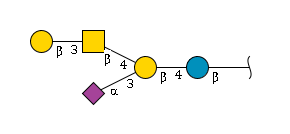
term (main_entry) : GM1
glycan_dictionary_accession : GSD000091
glytoucan_accession : G48558GR
term_in_sentence : GM1-induced fluidization of the phospholipid membranes and probable physical contact between bulky sugar head group of GM1 and spectrin, may explain the modulatory role of GM1 on aminophospholipid interactions with nonerythroid brain spectrin.[PMID: 29920238]
publication : 18524657|31761138|36180805|29920238|33859490|31937438|25762012|25931034|31776384|32013258|30776097|31048748|31447771|30292198|28796418|27806275|21076871|27552916|17986147|26960162|27815022|25851126|32916822|11462671|28236574|15911874|28577204|28497346|1794005|31934908|30267299|16902585|29439846|32325905|29747823|27576485|26338710|27858734|24501414|26818965|26629687|26958633|1854596|32134593|32198666|6619101
definition : A branched amino pentasaccharide consisting of the linear sequence β-D-Gal-(1→3)-β-D-GalNAc-(1→4)-β-D-Gal-(1→4)-β-D-Glc having a Neu5Ac residue attached to the inner galactose via an α-(2→3) linkage. The oligosaccharide of ganglioside GM1a.[CHEBI:59208]
term_xref : GlycoMotif:GGM.000098|GTC:G48558GR|CID:196569|CHEBI:59208|GlycoEpitope:EP0050|SugarBind_Ligand:13|KEGG:G00110
synonyms : GM1 ganglioside|GM1-ganglioside
function : The branched pentasaccharide chain of ganglioside GM1 is a prominent cell surface ligand, for example, for cholera toxin or tumor growth-regulatory homodimeric galectins.[PMID:16267866]
disease_associations : GM1 gangliosidosis (GM1) [PMID: 33859490]|Gastroenteritis[SugarBind_Ligand:13]|Actinomycosis[SugarBind_Ligand:13]|Lazy leukocyte syndrome[SugarBind_Ligand:13]|Toxoplasmosis[SugarBind_Ligand:13]|Cholera[SugarBind_Ligand:13]|Botulism[SugarBind_Ligand:13]
wikipedia : https://en.wikipedia.org/wiki/GM1
essentials_of_glycobiology : Chapter 11| Chapter 14
GM2
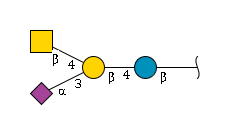
term (main_entry) : GM2
glycan_dictionary_accession : GSD000092
glytoucan_accession : G79389NT
term_in_sentence : GM1 gangliosidosis has both central nervous system and systemic findings; while, GM2 gangliosidosis is restricted primarily to the central nervous system.[PMID: 27491214]
publication : 29618308|27491214|32867370|30030044|27499644|31097363|29100724|27402091|31852956|30389374|30988135|8786814|14533808|23370522|28192816|32692591|29106755|28833537|11339652|9728335|27270764|9714704|26175473|27018595|28615102|28974375|32951593|11462672|28955902|17192692|26538065|25421609|9572057|11596983|15264019|23236285|11596984|31261761|30113798|24391178|24309906|22224667|7980537|18272501|9006924|
definition : A branched amino tetrasaccharide consisting of the linear sequence β-D-GalNAc-(1→4)-β-D-Gal-(1→4)-β-D-Glc having a Neu5Ac residue attached to the galactose via an α-(2→3) linkage. Corresponds to the carbohydrate portion of ganglioside GM2.[CHEBI:59220]
term_xref : GlycoMotif:GGM.000095|GTC:G79389NT|CID:45266845|CHEBI:59220|GlycoEpitope:EP0051|SugarBind_Ligand:39|KEGG:G00109|KEGG:G10351
synonyms :
function :
disease_associations : lung adenocarcinoma[GlycoEpitope:EP0051]|embryonal carcinoma[GlycoEpitope:EP0051]|germ cell tumor[GlycoEpitope:EP0051]|teratocarcinoma[GlycoEpitope:EP0051]|squamous cell carcinoma[GlycoEpitope:EP0051]|Gastroenteritis[SugarBind_Ligand:39]|Cholera[SugarBind_Ligand:39]|Clostridial myonecrosis[SugarBind_Ligand:39]|Tetanus[SugarBind_Ligand:39]
wikipedia : https://en.wikipedia.org/wiki/GM1_gangliosidoses
essentials_of_glycobiology : Chapter 11
GM3

term (main_entry) : GM3
glycan_dictionary_accession : GSD000093
glytoucan_accession : G91237TK
term_in_sentence : We also demonstrated an essential role of GM3 in murine and human auditory systems; a common pathological feature of GM3S deficiency is deafness. [PMID: 29747813]
publication : 29376491|29747813|25613425|30318083|31526872|31004109|28019668|26434718|27313500|27539856|30111401|28544772|29407985|19364317|30190430|31297734|30091781|26043887|32183071|30665141|27873002|25801320|30209782|32378734|23050851|22768242|14993837|24934090|17638075|21518140|26102277|19759399|24502144|25303960|23564406|16636105|16491123|11259118|15102521|12724312|24985965|8496625|25403557|15690123|15939439|25893133|23591593|20634908|2004380|739008|
definition : Ganglioside GM3 (d18:1/16:0) is a glycosphingolipid (ceramide and oligosaccharide)or oligoglycosylceramide with one or more sialic acids (i.e. n-acetylneuraminic acid) linked on the sugar chain. It is a component the cell plasma membrane which modulates cell signal transduction events. Gangliosides have been found to be highly important in immunology. Ganglioside GM3 carries a net-negative charge at pH 7.0 and is acidic. Gangliosides can amount to 6% of the weight of lipids from brain, but they are found at low levels in all animal tissuesGangliosides are glycosphingolipids. There are four types of glycosphingolipids, the cerebrosides, sulfatides, globosides and gangliosides. Gangliosides are very similar to globosides except that they also contain N-acetyl neuraminic acid (NANA) in varying amounts. The specific names for the gangliosides provide information about their structure. The letter G refers to ganglioside, and the subscripts M, D, T and Q indicate that the molecule contains mono-, di-, tri and quatra-sialic acid. The numbered subscripts 1, 2 and 3 refer to the carbohydrate sequence that is attached to the ceramide. In particular, 1 stands for GalGalNAcGalGlc-ceramide, 2 stands for GalNAcGalGlc-ceramide and 3 stands for GalGlc-ceramide. Deficiencies in lysosomal enzymes that degrade the carbohydrate portions of various gangliosides are responsible for a number of lysosomal storage diseases such as Tay-Sachs disease, Sandhoff disease, and GM1 gangliosidosis. The carbohydrate portion of the ganglioside GM1 is the site of attachment of cholera toxin, the protein secreted by Vibrio cholerae.[HMDB0004844]
term_xref : GlycoMotif:GGM.000090|GTC:G91237TK|CID:5288424|CHEBI:59226|GlycoEpitope:EP0053|SugarBind_Ligand:35
synonyms :
function : Membrane stabilizer|Energy source|Energy storage|Molecular messenger:|Signaling molecule[HMDB0004844]
disease_associations : Gastroenteritis[SugarBind_Ligand:35]|Chronic gastritis[SugarBind_Ligand:35]|Toxoplasmosis[SugarBind_Ligand:35]|Peptic ulcerSugarBind_Ligand:35]|Gastric cancer[SugarBind_Ligand:35]|Influenza[SugarBind_Ligand:35]|Diarrhea[SugarBind_Ligand:35]|Botulism[SugarBind_Ligand:35]
wikipedia :
essentials_of_glycobiology : Chapter 37
GM4

term (main_entry) : GM4
glycan_dictionary_accession : GSD000094
glytoucan_accession : G30207PZ
term_in_sentence : GM4 is synthesized by the sialylation of galactosylceramide (GalCer), while the ganglioside GM3 is synthesized by the sialylation of lactosylceramide (LacCer).[PMID:23999868]
publication : 23999868|2332419|12091485|19542236|8407875|23320941|28808804|3621237|23203271|7057115|26362868|6170387|18034482|7076644|2391348|25464080|3701369|11217952|6201236|30744426|9388026|27177620|30246056|15979459|7586078|6779816|29402905|7335153|3306476|17499534|7074082|9668345|3701884|26862430|6831238|27311552|26831445|24417799|7097284|4169231|16854400|26483798
definition : An amino disaccharide consisting of β-D-galactose having an α-N-acetylneuraminyl residue attached at the 3-position [CHEBI:63155]
term_xref : GlycoMotif:GGM.000089|GTC:G30207PZ|CID:5289366|CHEBI:63155|KEGG:G00317|SugarBind_Ligand:110
synonyms : Sialylated GalCer
function :
disease_associations : Chronic gastritis[SugarBind_Ligand:110]|Peptic ulcers[SugarBind_Ligand:110]|Gastric cancer[SugarBind_Ligand:110]
wikipedia :
essentials_of_glycobiology : Chapter 11|Chapter 15|Chapter 44|Appendix 45A
GP1c
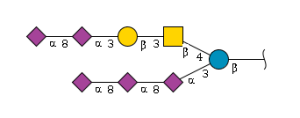
term (main_entry) : GP1c
glycan_dictionary_accession : GSD000095
glytoucan_accession : G93805MV
term_in_sentence : n this report, we describe an efficient convergent synthesis of the GP1c glycolipid epitope, which is one of the most complex c-series gangliosides. [PMID:19053458]
publication : [https://pubmed.ncbi.nlm.nih.gov/[https://pubmed.ncbi.nlm.nih.gov/1606358 1606358 1606358] [https://pubmed.ncbi.nlm.nih.gov/1606358 1606358 1606358]]|19053458|[https://pubmed.ncbi.nlm.nih.gov/1695858 1695858 1695858]|4091974|10775425|[https://pubmed.ncbi.nlm.nih.gov/2468656 2468656 2468656]|[https://pubmed.ncbi.nlm.nih.gov/2299350 2299350 2299350]|3064875|11432974|[https://pubmed.ncbi.nlm.nih.gov/[https://pubmed.ncbi.nlm.nih.gov/9613831 9613831 9613831] [https://pubmed.ncbi.nlm.nih.gov/9613831 9613831 9613831]]|11831845|1879553|[https://pubmed.ncbi.nlm.nih.gov/[https://pubmed.ncbi.nlm.nih.gov/10699494 10699494 10699494] [https://pubmed.ncbi.nlm.nih.gov/10699494 10699494 10699494]]|8969459|[https://pubmed.ncbi.nlm.nih.gov/[https://pubmed.ncbi.nlm.nih.gov/8474578 8474578 8474578] [https://pubmed.ncbi.nlm.nih.gov/8474578 8474578 8474578]]|[https://pubmed.ncbi.nlm.nih.gov/12031286 12031286 12031286]|1304332|[https://pubmed.ncbi.nlm.nih.gov/9153001 9153001 9153001]|[https://pubmed.ncbi.nlm.nih.gov/[https://pubmed.ncbi.nlm.nih.gov/10564776 10564776 10564776] [https://pubmed.ncbi.nlm.nih.gov/10564776 10564776 10564776]]
definition :
term_xref : GlycoMotif:GGM.000118|GTC:G93805MV
synonyms :
function :
disease_associations :
wikipedia :
essentials_of_glycobiology : Chapter 11|Chapter 14|Chapter 27|Chapter 35|Chapter 45 |Chapter 47|Chapter 49
GQ1b
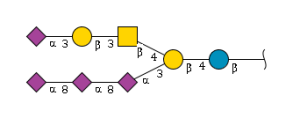
term (main_entry) : GQ1b
glycan_dictionary_accession : GSD000096
glytoucan_accession : G18625KA
term_in_sentence : Bilateral infusion of GQ1b into the hippocampus ameliorates cognitive deficits in the triple-transgenic AD mouse model (3xTg-AD).[PMID:31186474]
publication : 30798387|31186474|26704905|23677659|26984947|24184316| 23804237|9819299|18514410|22189683|24859332
definition : An amino oligosaccharide that is a branched octasaccharide derivative consisting of four sialyl residues, two galactose residues, one N-acetylglucosamine and a glucose residue at the reducing end.[CHEBI:59212]
term_xref : GlycoMotif:GGM.000115|GTC:G18625KA|GlycoEpitope:EP0069|CID:45266843|KEGG:G00117|CHEBI:59212
synonyms :
function :
disease_associations :
wikipedia :
essentials_of_glycobiology : Chapter 11
GQ1ba
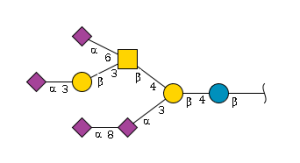
term (main_entry) : GQ1ba
glycan_dictionary_accession : GSD000097
glytoucan_accession : G54733XO
term_in_sentence : A few studies have reported the association of autoantibodies to GM1 or GQ1bα with Alzheimer's disease (AD) or vascular dementia.[PMID:25024341]
publication : 25024341|23717411|17870542|10702226|21137678|26748510|8662799|21274438|24649890|16580208|28124591|20095613|17507233|23565921|14505645|20930939|9201997
definition :
term_xref : GlycoMotif:GGM.000116|GTC:G54733XO
synonyms : GQ1balpha
function :
disease_associations :
wikipedia :
essentials_of_glycobiology :
GQ1c
term (main_entry) : GQ1c
glycan_dictionary_accession : GSD000098
glytoucan_accession : G99524KA
term_in_sentence : The neural specific monoclonal antibody A2B5 was found to interact with GQ1c but not with Gq1b, nor did it interact with other glycolipids such as GM1, GD1a, GD1b, GT1a, GT1b and GA1.[PMID: 6640289]
publication : 6640289|[https://pubmed.ncbi.nlm.nih.gov/1695858 1695858 1695858]|[https://pubmed.ncbi.nlm.nih.gov/7798936 7798936 7798936]|1729139|[https://pubmed.ncbi.nlm.nih.gov/2468656 2468656 2468656]|20368669|[https://pubmed.ncbi.nlm.nih.gov/2723647 2723647 2723647]|1814411|3064875|6085330|[https://pubmed.ncbi.nlm.nih.gov/1613492 1613492 1613492]|17883393|11831845|10775425|8219015|8804704|1384262|[https://pubmed.ncbi.nlm.nih.gov/7066685 7066685 7066685]|2299192|[https://pubmed.ncbi.nlm.nih.gov/9613831 9613831 9613831]|10350354|1304337|9153001|11959025|[https://pubmed.ncbi.nlm.nih.gov/8474578 8474578 8474578]|2299350|[https://pubmed.ncbi.nlm.nih.gov/10564776 10564776 10564776]|[https://pubmed.ncbi.nlm.nih.gov/10699494 10699494 10699494]|3942818|12031286|[https://pubmed.ncbi.nlm.nih.gov/7361620 7361620 7361620]
definition : Alpha-Neu5Ac-(2->8)-alpha-Neu5Ac-(2->8)-alpha-Neu5Ac-(2->3)-[alpha-Neu5Ac-(2->3)-beta-D-Galp-(1->3)-beta-D-GalpNAc-(1->4)]-beta-D-Galp-(1->4)-beta-D-Glcp is a member of neuraminic acids and an amino octasaccharide.[CID:91860352]
term_xref : GlycoMotif:GGM.000117|GTC:G99524KA|CID:91860352|CHEBI:145645|KEGG:G00121
synonyms :
function :
disease_associations :
wikipedia :
essentials_of_glycobiology : Chapter 46
GT1a
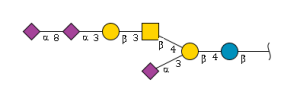
term (main_entry) : GT1a
glycan_dictionary_accession : GSD000099
glytoucan_accession : G68110IF
term_in_sentence : GT1a mimicry was found in the lipo-oligosaccharides of strain ICDCCJ07002 and ICDCCJ07004; but a combination of GM3/GD3 mimics was observed in ICDCCJ07001, although this patient had anti-GT1a IgG antibodies.[PMID:26197476]
publication : 12023422|32623212|26197476|9585812|29747820|23804237|11993188|31683059|19631994|9742882|29709941|8971119|8706663|893404|31829433|8910600|30600291|29319803|26176883|29063860|6766128|31602715|29808463|30711390|29847988|30116054|28187751
definition : A branched heptasaccharide derivative consisting of three sialyl residues, two galactose residues, one N-acetylglucosamine and a glucose residue at the reducing end.[CHEBI:59215]
term_xref : CID:45266863|GlycoMotif:GGM.000110|GTC:G68110IF|GlycoEpitope:EP0066|KEGG:G00112|CHEBI:59215
synonyms :
function :
disease_associations :
wikipedia :
essentials_of_glycobiology :
GT1a alpha
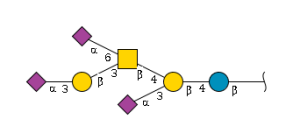
term (main_entry) : GT1a alpha
glycan_dictionary_accession : GSD000100
glytoucan_accession : G02149VR
term_in_sentence : A new class of gangliosides, GT1a alpha and GQ1b alpha, were initially identified as cholinergic neuron-specific antigens in bovine brain. [PMID:8082783]
publication : 7710562|8082783|10972137|9468624|9143254|8221098|9679279|11368158|11878808
definition :
term_xref : GlycoMotif:GGM.000111|GTC:G02149VR|GlycoEpitope:EP0111|CID:91851751|CHEBI:156678|KEGG:G00128
synonyms : GT1aa
function : GT1a alpha was a cholinerginic-specific antigen.[GlycoEpitope:EP0111]
disease_associations :
wikipedia :
essentials_of_glycobiology :
GT1b
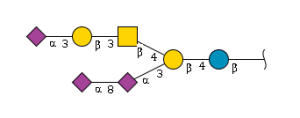
term (main_entry) : GT1b
glycan_dictionary_accession : GSD000101
glytoucan_accession : G40183QN
term_in_sentence : GT1b ganglioside is axonally transported to the spinal cord dorsal horn and contributes to characteristics of neuropathic pain such as mechanical and thermal hypersensitivity.[PMID: 32030804]
publication : 32030804|26370787|32046393|9712688|7636307|9931455|25520869|19605473|17188834|10233751|22735313|20540782|22746533|1861141|19490186|9521848|11921200|10731661|31431523|15274627|32726962|12573517|18277613|11370834|11234774|11123278|18704164|16291967|11411041|27549393|25253868|22720883|10686582|11511306|29904724|31472390|19156870
definition : A branched amino heptasaccharide comprising a β-D-galactosyl-(1→4)-β-D-glucose disaccharide, the galactosyl residue of which carries an N-acetyl-α-neuraminyl-(2→3)-β-D-galactosyl-(1→3)-N-acetyl-β-D-galactosaminyl trisaccharide unit and an N-acetyl-α-neuraminyl-(2→8)-N-acetyl-α-neuraminyl disaccharide unit through (2→4) and (2→3) linkages respectively. It corresponds to the carbohydrate portion of ganglioside GT1b.[CHEBI:59225]
term_xref : GlycoMotif:GGM.000112|GTC:G40183QN|GlycoEpitopeEP0067|CID:45266781|CHEBI:59225| GlycoGlycoEpitope:130680|SugarBind_Ligand:26|KEGG:G00116
synonyms :
function :
disease_associations : Toxoplasmosis[SugarBind_Ligand:26]|Lyme disease[SugarBind_Ligand:26]|Cholera[SugarBind_Ligand:26]|Botulism[SugarBind_Ligand:26]|Tetanus[SugarBind_Ligand:26]|Influenza[SugarBind_Ligand:26]
wikipedia :
essentials_of_glycobiology :
GT1c
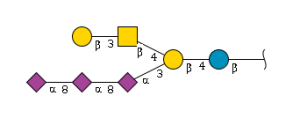
term (main_entry) : GT1c
glycan_dictionary_accession : GSD000102
glytoucan_accession : G78818SP
term_in_sentence : We show here that VVH associates with ganglioside GM1a, Fucosyl-GM1, GD1a, GT1c, and GD1b by glycan array.[PMID: 32228455]
publication : 28088450|30085356|32228455|2468656|19841910|23877172|1695858|10564776|1613492|8474578|7798936|11180643|2723647|7066685|9613831|7361620|10699494
definition : A branched amino heptasaccharide consisting of a linear tetrasaccharide of β-D-galactose, N-acetyl-β-D-galactosamine, β-D-galactose and β-D-glucose residues linked sequentially (1→3), (1→4) and (1→4), to the galactose residue proximal to the reducing end is also linked (2→3) an N-acetyl-α-neuraminyl-(2→8)-N-acetyl-α-neuraminyl-(2→8)-N-acetyl-α-neuraminyl trisaccharide side-chain. The carbohydrate moiety of ganglioside GT1c.[CHEBI:90509]
term_xref : GlycoMotif:GGM.000113|GTC:G78818SP|CID:91846734|CHEBI:90509|GlycoEpitope:EP0033|KEGG:G00120
synonyms :
function :
disease_associations :
wikipedia :
essentials_of_glycobiology :
GT2
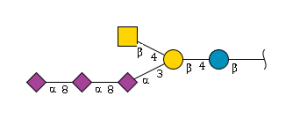
term (main_entry) : GT2
glycan_dictionary_accession : GSD000103
glytoucan_accession : G36476BA
term_in_sentence : Biosynthesis of the c-series gangliosides GT3, GT2 and GP1c was studied in Golgi derived from rat liver.[PMID: 1606358]
publication : 1606358|15498585|16005859|27540730|31533196|31201844
definition : A branched amino hexasaccharide consisting of a chain of three α-sialyl residues, a β-D-galactosyl residue and a β-D-glucose residue linked sequentially (2→8), (2→8), (2→3) and (1→4), to the galactosyl residue of which is also linked (1→4) an N-acetyl-β-D-galactosaminyl residue. The carbohydrate moiety of ganglioside GT2.[CHEBI:72446]
term_xref : GlycoMotif:GGM.000109|GTC:G36476BA|CID:70788971|CHEBI:72446|KEGG:G00119
synonyms :
function :
disease_associations :
wikipedia :
essentials_of_glycobiology : Chapter 11
GT3

term (main_entry) : GT3
glycan_dictionary_accession : GSD000104
glytoucan_accession : G93899SO
term_in_sentence : The purpose of this study was two-fold: (1) to formulate γ-tocotrienol (GT3) in a nanoemulsion formulation as a prophylactic orally administered radioprotective agent; and (2) to optimize the storage conditions to preserve the structural integrity of both the formulation and the compound.[PMID: 28029115]
publication : 28029115|31355968|30987413|27869747|27216753|8631981|29672891|10385047|29642403|10412028|27193023|30068561|23415908|8858920|2303428|27153057|27128741|2654294|26930378|7561885|25860286|30845647|24712339|30070965|8910600|1606358|27356050|8514740|18509108|23000517|29769046|29566611
definition : A linear amino pentasaccharide consisting of a chain of three α-sialyl residues, a β-D-galactosyl residue and a β-D-glucose residue linked sequentially (2→8), (2→8), (2→3) and (1→4).[CHEBI:72444]
term_xref : GlycoEpitope:EP0070|KEGG:G00118|CID:70788970|GlycoMotif:GGM.000092|GTC:G93899SO|CHEBI:72444
synonyms :
function :
disease_associations :
wikipedia :
essentials_of_glycobiology : Chapter 11